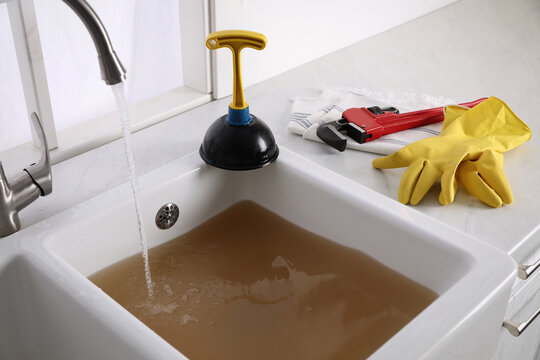Ways to Successfully Apply Plungers and Drain Cleaners: Expert Insights
Ways to Successfully Apply Plungers and Drain Cleaners: Expert Insights
Blog Article
Have you been looking for information and facts about Tips on How to Effectively Use a Plunger?

Introduction
Correct maintenance of house drains is crucial for protecting against clogs and ensuring smooth water circulation. Among the trick tools in every property owner's toolkit is the plunger, along with different drain cleansers created to deal with persistent blockages effectively. This write-up checks out how to utilize plungers and drainpipe cleansers successfully to maintain your drains moving freely.
Area 1: Understanding Plungers
Sorts of Plungers
There are several kinds of bettors available, each developed for various sorts of drains and blocks. One of the most usual kinds include mug plungers, flange plungers, and accordion bettors.
Just How Plungers Work
Plungers service the concept of creating pressure and suction to remove obstructions. When properly applied over a drain, they produce a vacuum cleaner that can take out debris or break up clogs.
Picking the Right Plunger
Picking the ideal plunger relies on the sort of drainpipe and the nature of the obstruction. Cup bettors are optimal for sinks and tubs, while flange bettors are much better fit for toilets due to their layout.
Common Blunders with Bettors
Avoiding these blunders makes sure effective plunging: inappropriate seal around the drain, not enough force, and unclear surrounding debris.
Area 2: Utilizing Plungers Effectively
Preparation
Prior to diving, guarantee the bettor covers the drainpipe completely and develops a limited seal. Clear any visible debris around the drainpipe opening.
Strategy
Beginning with gentle plunging movements to build suction. Boost stress gradually, utilizing a steady rhythm. Repeat as necessary up until the drainpipe clears.
Fixing Tips
If diving doesn't function, attempt adjusting the seal, applying oil jelly for a better seal, or making use of a various type of plunger.
Section 3: Comprehending Drain Cleansers
Kinds Of Drainpipe Cleaning Company
Drain pipes cleaners can be chemical or chemical. Chemical cleansers utilize solid chemicals to liquify blockages, while enzymatic cleansers utilize natural enzymes to break down organic matter.
Just How Drainpipe Cleaners Job
Chemical cleansers react with obstructions to liquify them, while chemical cleaners break down organic products like hair and grease without hurting pipes.
Safety Factors to consider
Constantly use gloves and eye defense when utilizing chemical drainpipe cleansers. Guarantee ample ventilation and adhere to producer guidelines very carefully.
Eco-Friendly Alternatives
Consider utilizing vinegar and cooking soda or enzyme-based cleansers for eco-friendly choices that are more secure for pipelines and the environment.
Section 4: Making Use Of Drain Cleaning Company Effectively
Application Methods
Put chemical cleaners directly right into the drainpipe opening. Allow them to help the advised time before flushing with hot water. Chemical cleansers should sit over night.
Preventative measures
Avoid mixing different kinds of cleaners, as this can create poisonous fumes. Never ever make use of chemical cleansers along with a plunger, as splashing can occur.
Dealing With Stubborn Clogs
For persistent clogs, consider making use of a plumbing serpent or calling a professional plumbing professional to avoid damages to pipes.
Verdict
Finally, comprehending how to make use of plungers and drainpipe cleaners effectively is vital for preserving healthy and balanced plumbing systems. By picking the right tools and methods, home owners can tackle minor blockages and prevent major pipes concerns down the line.
How To Properly Use A Plumbing Snake To Clear Drains
When any drain clogs in our home arise, we tend to gravitate toward the plunger and little else. In cases where the plunger and its vacuum-created pressure are not able to clear clogs, many immediately move to harmful chemicals or simply call their plumber to fix the issue.
we’re happy to help with all drain cleaning needs and concerns. This includes informing you on a few other home remedies you may have at your disposal for minor to moderate clogs, one of which is the use of a plumbing snake. Many people have never used one of these before – let’s go over the steps to take when your drain clogs and you have a plumbing snake available.
Attempt Plunger Use
The first step here, as we noted above, should indeed be to grab your plunger when you notice a drain clog and attempt to resolve it this way. If you’re unsure how to use a particular type of plunger, our plumbers can answer any questions you have. If this doesn’t do the trick, however, you move on to the snake.
Locate And Prepare Snake
A plumbing snake is a metal or plastic device that’s generally about a quarter of an inch thick. It’s design with significant extensions, meant to reach down into your clogged drain and push the clog out. Snakes also contain drain augers that will latch onto and push stubborn blockages.
If your plunger doesn’t clear a clog, locate your snake and bring it to the drain in question. We also recommend keeping a bucket nearby to collect the clog once you pull it out, plus we’d advise wearing goggles and possibly protective gloves.
Feed Snake
Once you’re ready to go, feed the snake slowly down the drain, using the crank device it comes with to keep it moving until it finds the clog. Once this happens, much of the clog will be latched onto the coil so you can pull it out, while the rest will simply break up and flow downward.
Detach Debris
Remove the snake slowly from the drain, and once you’ve done so, pick off any debris that’s stuck to the coil. This is another area where wearing gloves is a must.
Flush Drain
Finally, take a few minutes to ensure the snake has done its job correctly. If you’ve been using it on a toilet, flush the toilet a couple times and make sure everything flows well. If you’ve used it on a different drain, flush it with some room temperature water.
https://www.mybuddytheplumber.com/blog/how-to-properly-use-a-plumbing-snake-to-clear-drains/

Application Methods
Put chemical cleaners directly right into the drainpipe opening. Allow them to help the advised time before flushing with hot water. Chemical cleansers should sit over night.
Preventative measures
Avoid mixing different kinds of cleaners, as this can create poisonous fumes. Never ever make use of chemical cleansers along with a plunger, as splashing can occur.
Dealing With Stubborn Clogs
For persistent clogs, consider making use of a plumbing serpent or calling a professional plumbing professional to avoid damages to pipes.
Verdict
Finally, comprehending how to make use of plungers and drainpipe cleaners effectively is vital for preserving healthy and balanced plumbing systems. By picking the right tools and methods, home owners can tackle minor blockages and prevent major pipes concerns down the line.
How To Properly Use A Plumbing Snake To Clear Drains
When any drain clogs in our home arise, we tend to gravitate toward the plunger and little else. In cases where the plunger and its vacuum-created pressure are not able to clear clogs, many immediately move to harmful chemicals or simply call their plumber to fix the issue.
we’re happy to help with all drain cleaning needs and concerns. This includes informing you on a few other home remedies you may have at your disposal for minor to moderate clogs, one of which is the use of a plumbing snake. Many people have never used one of these before – let’s go over the steps to take when your drain clogs and you have a plumbing snake available.
Attempt Plunger Use
The first step here, as we noted above, should indeed be to grab your plunger when you notice a drain clog and attempt to resolve it this way. If you’re unsure how to use a particular type of plunger, our plumbers can answer any questions you have. If this doesn’t do the trick, however, you move on to the snake.
Locate And Prepare Snake
A plumbing snake is a metal or plastic device that’s generally about a quarter of an inch thick. It’s design with significant extensions, meant to reach down into your clogged drain and push the clog out. Snakes also contain drain augers that will latch onto and push stubborn blockages.
If your plunger doesn’t clear a clog, locate your snake and bring it to the drain in question. We also recommend keeping a bucket nearby to collect the clog once you pull it out, plus we’d advise wearing goggles and possibly protective gloves.
Feed Snake
Once you’re ready to go, feed the snake slowly down the drain, using the crank device it comes with to keep it moving until it finds the clog. Once this happens, much of the clog will be latched onto the coil so you can pull it out, while the rest will simply break up and flow downward.
Detach Debris
Remove the snake slowly from the drain, and once you’ve done so, pick off any debris that’s stuck to the coil. This is another area where wearing gloves is a must.
Flush Drain
Finally, take a few minutes to ensure the snake has done its job correctly. If you’ve been using it on a toilet, flush the toilet a couple times and make sure everything flows well. If you’ve used it on a different drain, flush it with some room temperature water.
https://www.mybuddytheplumber.com/blog/how-to-properly-use-a-plumbing-snake-to-clear-drains/

We hope you enjoyed our section about How to Unclog Your Sink with a Plunger. Thank you for finding the time to read our posting. Are you aware of anybody else who is in the market for Tips on How to Effectively Use a Plunger? Feel free to share it. Bless you for being here. Revisit us soon.
View More Report this page